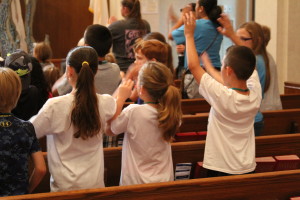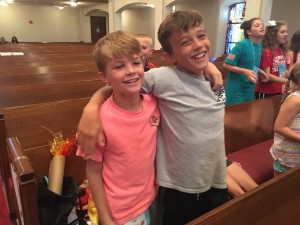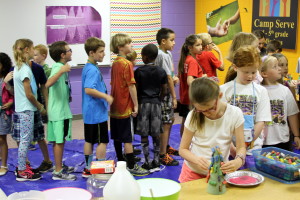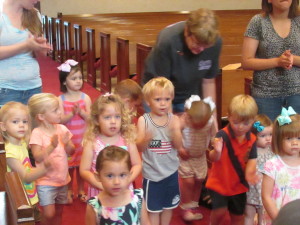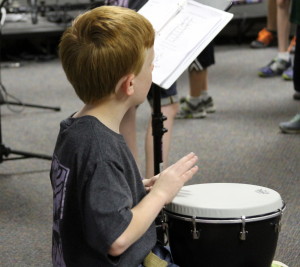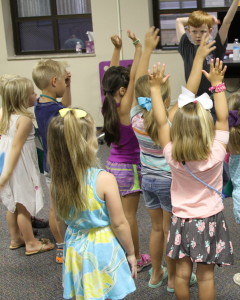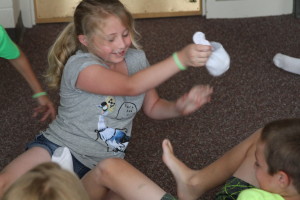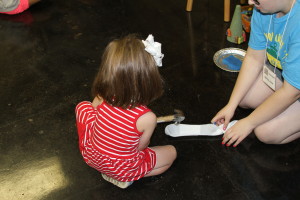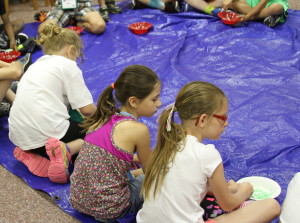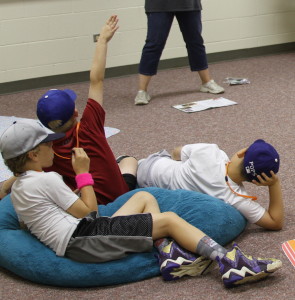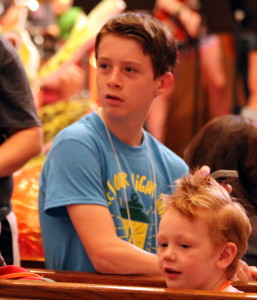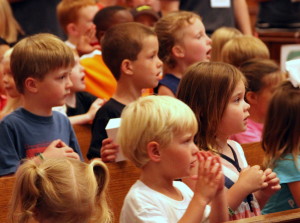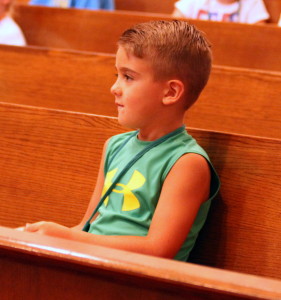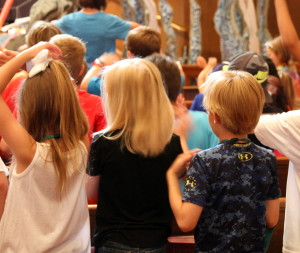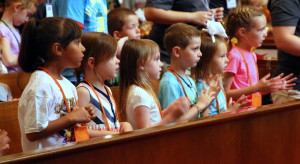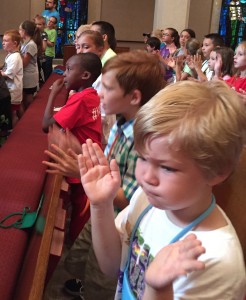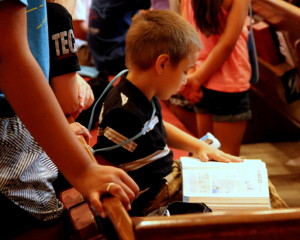FIRST STORIES: Barbara Yarbrough
The sharing of life stories is immensely important, imparting the knowledge and wisdom gained through a lifetime of experiences from one generation. Hearing such stories enriches all the listeners, providing both encouragement and the challenge to model such a well-lived life. The tradition of imparting generational accounts around a fire reaches back to the beginning of the human experience. First Stories is a winter series where once a month listeners gather around the Main Street Café fireplace to hear a longtime member of First Methodist share his or her life story in an intimate session. The events are recorded and become a part of the church archives and also provide present and future generations the opportunity to hear these stories. So, take your cup of hot chocolate or coffee, find a comfortable spot to sit, and join us virtually beside the fireplace for First Stories.
On January 27, Barbara Yarbrough began the 2019 First Stories winter series. You are sure to be inspired by Barbara’s story of overcoming many childhood challenges in Houston, moving to Midland, and her years of educating and influencing countless young people. Barbara shared of God’s faithfulness, His provision, the people He placed in her life at just the right times, and how her life has taken many unexpected turns. She is a remarkable woman with a remarkable story. You are sure to enjoy her story and benefit from having heard it.
FIRST STORIES: Doc and Gayle Dodson
The sharing of life stories is immensely important, imparting the knowledge and wisdom gained through a lifetime of experiences from one generation. Hearing such stories enriches all the listeners, providing both encouragement and the challenge to model such a well-lived life. The tradition of imparting generational accounts around a fire reaches back to the beginning of the human experience. First Stories is a winter series where once a month listeners gather around the Main Street Café fireplace to hear a longtime member of First Methodist share his or her life story in an intimate session. The events are recorded and become a part of the church archives and also provide present and future generations the opportunity to hear these stories. So, take your cup of hot chocolate or coffee, find a comfortable spot to sit, and join us virtually beside the fireplace for First Stories.
Doc and Gayle Dodson were the final speakers of the 2018 Winter First Stories series on April 22, which was also Doc’s birthday. The Dodsons shared stories of growing up, coming to Midland, meeting each other, and events from their very active lives as pillars of the Midland community. The audience enjoyed the humorous stories and the family memorabilia pieces on display. The evening culminated with the singing of the Dodsons’ favorite hymn, “What a Friend We Have in Jesus” followed by birthday cake for all present!
FIRST STORIES: Bob Davis

The sharing of life stories is immensely important, imparting the knowledge and wisdom gained through a lifetime of experiences from one generation. Hearing such stories enriches all the listeners, providing both encouragement and the challenge to model such a well-lived life. The tradition of imparting generational accounts around a fire reaches back to the beginning of the human experience. First Stories is a winter series where once a month listeners gather around the Main Street Café fireplace to hear a longtime member of First Methodist share his or her life story in an intimate session. The events are recorded and become a part of the church archives and also provide present and future generations the opportunity to hear these stories. So, take your cup of hot chocolate or coffee, find a comfortable spot to sit, and join us virtually beside the fireplace for First Stories.
************************************************
Bob Davis, the third speaker for the 2018 Winter First Stories entertained the audience with surprising stories from his life that included getting food poisoning on a bus, a short time in a prisoner of war camp, and an unfortunate fireworks experience while in college. Bob charmed the audience with poetry, wit, and had them laughing with several very humorous stories. Bob’s wife, Cecelia, and several family members were present. You are certain to enjoy Bob’s stories.
FIRST STORIES: Loyce Cole

The sharing of life stories is immensely important, imparting the knowledge and wisdom gained through a lifetime of experiences from one generation. Hearing such stories enriches all the listeners, providing both encouragement and the challenge to model such a well-lived life. The tradition of imparting generational accounts around a fire reaches back to the beginning of the human experience. First Stories is a winter series where once a month listeners gather around the Main Street Café fireplace to hear a longtime member of First Methodist share his or her life story in an intimate session. The events are recorded and become a part of the church archives and also provide present and future generations the opportunity to hear these stories. So, take your cup of hot chocolate or coffee, find a comfortable spot to sit, and join us virtually beside the fireplace for First Stories.
On February 25, Loyce Cole shared her life experiences. She spoke of growing up on a ranch near Midland and shared a picture of her childhood home. Loyce recounted how she met her husband, as well as how God brought their children into their lives and the adventures of their family in Alaska. The children present at this second Winter 2018 First Stories series especially enjoyed the artifacts Loyce brought, which included Eskimo thimbles, moccasins, volcanic ash, and a real gold nugget. All in attendance were blessed by the hearing of her stories. Enjoy these stories from Loyce’s life experiences.
FIRST STORIES: Bob Boothe
The sharing of life stories is immensely important, imparting the knowledge and wisdom gained through a lifetime of experiences from one generation. Hearing such stories enriches all the listeners, providing both encouragement and the challenge to model such a well-lived life. The tradition of imparting generational accounts around a fire reaches back to the beginning of the human experience. First Stories is a winter series where once a month listeners gather around the Main Street Café fireplace to hear a longtime member of First Methodist share his or her life story in an intimate session. The events are recorded and become a part of the church archives and also provide present and future generations the opportunity to hear these stories. So, take your cup of hot chocolate or coffee, find a comfortable spot to sit, and join us virtually beside the fireplace for First Stories.
Bob Boothe was the inaugural speaker for the 2018 Winter Series. Bob entertained and inspired the live audience with his positive outlook on life. He helped all present see God’s hand guiding him through his varied life experiences from learning to fly an airplane at age 16, across multiple careers, service in both the Army and Navy, international travels to many countries (including Russia during the Cold War), and even while traveling the country as a dog show judge. Enjoy Bob’s rich life story.
The View From Childhood
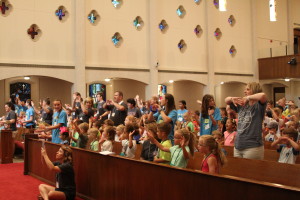
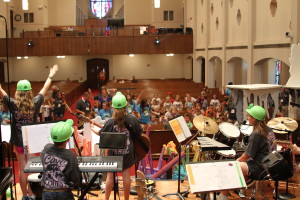 e for children. It’s ultimate goal is to place a spark of faith within their hearts and to provide a child-sized measure of experience with worship. All those who work in VBS–out front, as teachers and leaders, as support behind the scenes, as financiers–labor together to plant a small seed within the children who attend that they hope will sprout and grow and bring forth the fruit of regular worship. In other words, to make them into churchgoers, into the people who gather to worship God.
e for children. It’s ultimate goal is to place a spark of faith within their hearts and to provide a child-sized measure of experience with worship. All those who work in VBS–out front, as teachers and leaders, as support behind the scenes, as financiers–labor together to plant a small seed within the children who attend that they hope will sprout and grow and bring forth the fruit of regular worship. In other words, to make them into churchgoers, into the people who gather to worship God.At child level, Vacation Bible School looks quite different. It begins with a great rush of excitement–fun for some, bewildering for others, a little scary for a few. The time passes in a highly present-tense mode, with little knowledge of what comes next. Some of that will be mastered by the last day, but then its over. With the passage of time, the detail of what happened fades. The small clutch of artifacts collected and carried home will outlast most memories of these few days of early summer.
A SINGULAR EASTER BLESSING
Each year, the members of First Methodist work to create a distinctive atmosphere on the Sunday in May designated as Mother’s Day. Decorations, additional flowers, special treats from fresh fruit to chocolates adorn the corridors and worship areas. Guest speakers and artists frequently bring unique testimonies. All the ladies attending receive small gifts as they leave worship. Everyone attending enjoys the out of the ordinary atmosphere of celebration.
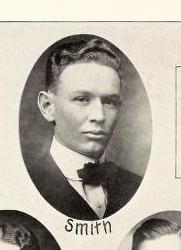
Smith followed a succession of middle-aged ministers who had come from other states and under whom the church had stagnated a bit. His youthful enthusiasm invigorated the church and quickly carried him into community leadership. He dropped the old church title of “Methodist Episcopal Church, South” and replaced it with the shorter and more dynamic title “First Methodist.”
The roots of the day extended much further into the past, however, another half-century back to the turbulent days just prior to the Civil War and held a special Methodist connection as well. In 1858, a young Appalachian homemaker named Ann Marie Reeves Jarvis began “Mothers Friendship Day” as an effort to improve sanitation. Part of her fervor to help others came from her faithful membership in her local Methodist church.
With the coming of the Civil War a few short years later, Jarvis shifted her efforts toward the care of wounded soldiers and better sanitary condition for both Union and Confederate armies. She was not alone in her work. Influential women like Julia Ward Howe undertook similar campaigns.
Ann Marie Reeves Jarvis continued her efforts until her death in 1905. Following her death, her daughter, Anna, dedicated her life to establishing Mother’s Day to “honor mothers, living and dead” and as a special memorial to her mother. She gained the financial backing from Philadelphia department store owner John Wanamaker and, in May 1908 the first official Mother’s Day celebration took place at her Methodist church in Grafton, West Virginia. That same day thousands of people attended a Mother’s Day event at one of Wanamaker’s Philadelphia stores.
Young Reverend Smith would remain in Midland for a second year. His next appointment was in Nashville, Tennessee. Smith would rise through the Methodist organization, earning an M. A. degree at Columbia and eventually earning several honorary Doctor of Divinity degrees. In 1944, he was elected to the Episcopacy of The Methodist Church and served as Bishop for Oklahoma and New Mexico.
Though his career eventually carried him far beyond the small church in Midland, Reverend W. Angie Smith and Bessie would always fondly remember their youthful days there and the special Mother’s Day heralding the arrival of Angie III.
- “Mother’s Day At Methodist Church, The Midland Reporter, May 19, 1922, p. 8.
- The Midland Reporter, October 28, 1921, p. 1.
- ”The History of Mother’s Day” http://www.theholidayspot.com/mothersday/history.htm#STvHTDy4XBAofzzF.99 accessed May 9, 2016.
- http://peacealliance.org/history-of-mothers-day-as-a-day-of-peace-julia-ward-howe/#sthash.T2nraEXf.dpuf accessed May 9, 2016.
- “Mother’s Day” http://www.history.com/topics/holidays/mothers-day accessed May 9, 2016.
- The Midland Reporter, May 26, 1922, p. 8.
Where We Live
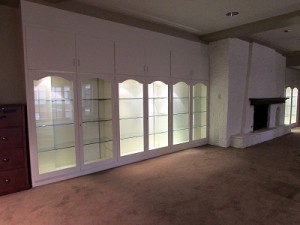
In the space that has served as the church Parlor for decades, the cases on the back wall sit empty. Along with all the room furnishings, the historical display has been removed as this area becomes part of the renovation project that began in November of 2015.
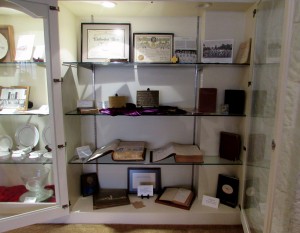
In 1999, as the twentieth century drew to a close, Church Historian Frances Atwater dreamed of displaying some of the historical information and memorabilia she discovered as she excavated various old files, boxes, and cabinets about the church. Her personal church history reached back to the age of eleven, when her family moved to Midland. Frances was an active church member from the beginning and remained so throughout her lifetime.
Frances and Gayle took their idea of a historical display to the Reverend Lane Boyd, who was Senior Pastor at that time, and other members of the church staff. They quickly gained support and a financial campaign for an Archives/History Fund was underway.
In 2002, they reached their goal of $11,500 and Rod Stephenson constructed the cases in the Parlor in January 2003.
Sadly, Frances was not there to see her dream completed. She died of cancer in April of 2002. But she passed away knowing her vision was quickly moving toward reality.
Gayle Dodson oversaw the layout of the historical display, which included photographs, commemorative items, historic records, Bibles and rare artifacts that had survived the years. By the spring of 2003, the display was completed. It even included a section honoring two special former church members, then President George W. Bush and First Lady Laura Welch Bush. Laura’s connection to this church went back to her baptism here. Years later, George and Laura had married in the Glass Chapel.
As she viewed the completed exhibit, Gayle recalled Frances. “At first sight of the finished project, my eyes filled with tears as I thought to myself, ‘Oh Frances, I wish you were here to see this.’ Of course she was there in spirit and jumping with joy as I was.”
Twelve years later, those cases sit empty as new dreams have re-imagined how we will use this space. By the very nature of renovation, some things have to go to make way for the new. The history cases are victims of that, but not the history.
For those, like Gayle and myself, who care about such things, all the items in the display cases have been securely stored away, along with information about them, as well as a set of photographs documenting the display itself.
I sift. I sort. I make my best judgments regarding what to preserve. Because, as Karen Salmonsohn reminds us, we cannot live in the past. Rather, if we are faithful Christians we are always building for the future.
History is a story we tell ourselves in the present that help explains who we are and how we arrived at the present moment. While its subject is the past–what actually happened–its true focus is the future. Perhaps the most important statement made by the empty cases is not that our history is lost but that we continue to work on new chapters of that history.
Museums honor the past by preserving all sorts of items from annihilation but it has been said that museums are where things go to die. That means they lose their original function and value. An old treadle sewing machine becomes a relic instead of an vital part of family life, for example.
We are not a museum. We are a church, where people come to find new life.
As old corridors are opened up, as old walls come down, as Apostle paintings and artifacts are stored away, we can certainly allow ourselves time for a little nostalgia for their passing. But only a few moments. Then, we should begin our work in helping construct the next piece of the story of First Methodist Midland.
“The past is good to learn from but not to live in.”
–Karen Salmonsohn
–Jim Collett, Church Historian
A Special Renovation
Since its dedication in 1976, the Mabel Holt Glass Memorial Chapel has served as the site for special moments in the history of First United Methodist Church of Midland. Worship services, weddings, funerals and memorial services have all taken place in the beautiful space. The family of Mrs. Glass helped make this chapel a reality and have helped sustain it over the years. Now, the continued generosity of her descendants will allow much needed renovations to take place.
Ted Johnson, Bert Johnson and Karen Scharbauer, descendants of Mrs. George W. (Mabel Holt) Glass, generously committed to underwriting the project.
Work has begun on the chapel and will take approximately ten weeks. During that time the chapel will be closed for all activities. The scope of the work will include renovation of the chancel flooring, reworking the sound fabric covering the organ pipes and speaker area, reworking the pulpit surface, repairing or replacing wall coverings, and repairing plaster around the windows. All floor coverings will be replaced. The pews and woodwork will be refinished and pew and chair cushions replaced. The existing sound system will be replaced and new sounds panels added. The lighting will be upgraded to allow for LED lighting and a new dimming system added.
The basic appearance and format of the chapel will not change. When completed the project will allow the chapel to continue to be a beautiful and viable part of First Methodist.
The original chapel project began in 1974 with a capital campaign entitled, “One Shining Light.” Pastor Timothy Guthrie led the congregation in an initiative to complete the payment of the debt incurred in building the sanctuary that remains in use today. In addition, the campaign proposed building “a small but extremely useful memorial chapel” to be erected at the corner of Main and Illinois, where the old sanctuary had once stood. Completing these two projects would finish a master building plan begun six years before. In the campaign booklet, Pastor Guthrie said, “Our beautiful church will shine before men as a symbol of work done and sacrifices made.”
George W. Glass, Mr. and Mrs. George Holt Glass and Mr. and Mrs. Ted Johnson pledged the funds, with the chapel to be a memorial to Mabel Holt Glass. Mabel was the daughter of O. B. Holt and Viola Josephine Bell, a pioneer family in early Midland. They were married by Midland Methodist pastor Nat Read in 1892 and remained lifelong members of First Methodist. Mrs. Holt served as church organist for many years.
Their daughter Mabel was born in 1905 and joined the church and was baptized in 1913. The Holts contributed a special stained glass window to the construction of the 1907 church, a beautiful brick church which replaced the original small wooden building. This window was given in memory of Mabel’s sister Cornelia who has perished from illness while still quite young. That window was preserved through later renovations and constructions of new sanctuaries. It now occupies a special place in entrance area to the chapel.
A graduate of what is now Texas Woman’s University, she taught school for several years in Stanton and Midland before she met and married George Glass in 1928. Like her parents Mabel was active in church affairs. She became a charter founder of the Boone Bible class, established in 1930, and was a member of the Women’s Society of Christian Service.
Mabel Holt Glass passed away in 1972. She was remembered as “a religious and spiritual woman, loved by many persons.” Her family’s support for a chapel in her memory reflected “the radiance which blessed those with whom she came in contact,” as well as “her dedication to God, the Bible, her church, her family and her community.”
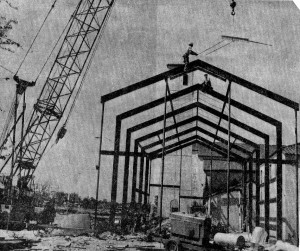
Chapel Under Construction in 1975
Over the years, the chapel, with its atmosphere of intimacy and sharing, has been filled with moments of joy and sorrow, laughter and tears, providing a special and beautiful place for events of faith. Many couples have begun their lives together there. Perhaps the most historic wedding in the chapel was the marriage of George W. Bush and Laura Welch on November 5, 1976.
![IMG_2724[1]](https://www.firstmethodistmidland.com/hp_wordpress/wp-content/uploads/2016/01/IMG_27241-300x225.jpg)
Renovated Chapel July 2015

